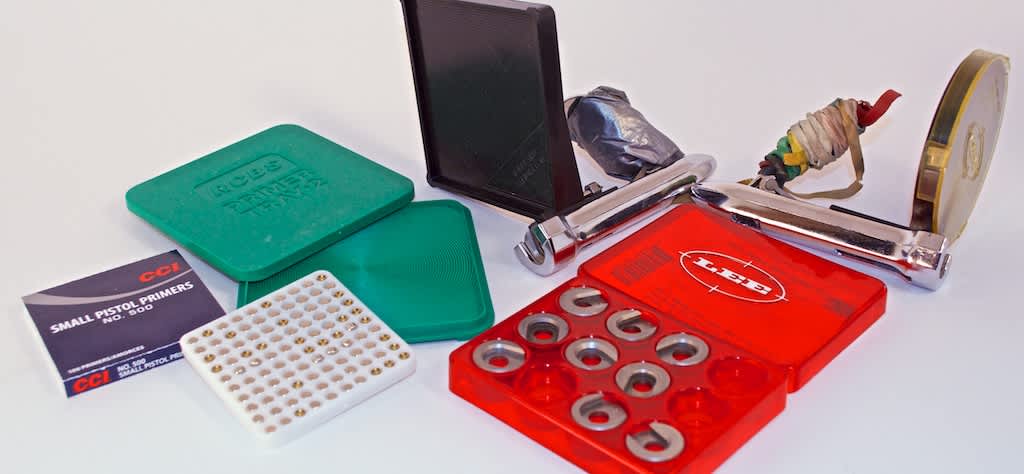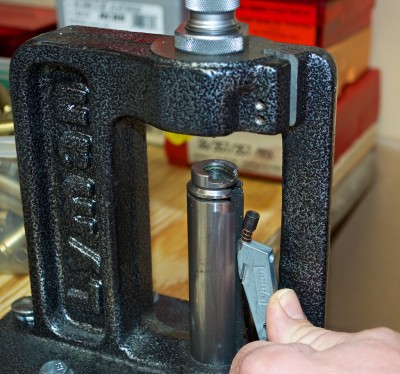Three Simple Ways to Complete the Priming Step of Reloading
Tom McHale 03.04.14

Last time we talked about about ways to resize brass like a boss. This week, let’s look at some different approaches to the re-priming step.
We’ll cover this from a “getting started” point of view. If you own something like a Dillon Precision Super 1050 progressive reloading press, you’ve spent somewhere approaching $2,000 and are auto-priming like there’s no tomorrow. Rock on!
On the other hand, if you’re thinking about getting into reloading, or have just started, we’ll help narrow the approaches by looking a few different methods. To keep things simple, let’s consider three different methods: hand priming, single-stage reloading press priming, and progressive reloading press priming. We’ll skip the budget method of hammering primers into place with a mallet, as that generally results in lost fingers and your quick enrollment onto the terrorist watch list.

Hand priming tools
The thought process behind hand priming tools is that you can easily, and cheaply, prime hundreds and hundreds of cartridge cases per hour. Better yet, you can do this from the comfort of just about anywhere. “Hand priming tool” is a literal definition and most of them are small, light, and portable. Want to camp out in the family room? No problem, bring a box of cases, your priming tool, and an empty box for your completed cases.
There’s another benefit of hand priming tools. You can control the pressure and depth of priming fairly well as you are pressing the new primer into place with a hand tool, not a hydraulic machine. After a couple hundred, you’ll develop a feel that tells you primers are seated correctly.
Here’s how they work. First you clean, decap (remove the spent primer), and resize your brass. Most hand primers have a tray that’s large enough to hold a box of 100 primers. Holding your opened box of primers, turn the hand priming tool tray upside-down over the primer packaging tray, then flip the whole assembly. If done correctly, you’ve now got all 100 primers in the hand primer tool tray. You’ll notice the tray is ridged or textured. That allows you to gently shake the tray until all the primers are facing upwards, so they will insert correctly. When all the primers are oriented correctly, put the cover over the tray to prevent primers from spilling and flipping.
Many hand priming tools use removable shell holders to hold the case still while a primer is pressed into place. The shell holders are sized to caliber. Once you’ve got the right shell holder in place, primers loaded and cover in place, you’re ready to prime. It’s a simple process. Insert a shell, squeeze the hand tool, and drive the primer into place. You’ll quickly learn the ideal angle at which to operate your hand primer so that the next-in-line primer falls into place by gravity.
Safety note: Always wear protective glasses when reloading. Primers are designed to explode when impacted, and by definition, you’re using force to press them into place. Also, make sure that the open mouth of the cartridge case is facing away from you when inserting primers! I don’t want to instill fear, as I’ve never had one detonate while reloading—it’s just always better to be safe than sorry!
Which hand priming tool should you buy? The good news is that there are a number of good ones. Here’s what I’ve learned. While pressing a single primer into place doesn’t require a whole lot of force, doing hundreds or thousands of them can wreak havoc on your hands. Look for one that has a wide and comfortable grip and a rounded activation lever. I prefer the type like the RCBS model shown here, where you support the tool with the large surface in the palm of your hand and work the lever with your fingers. Some work the opposite way. Some hand tools even feature a universal shell holding device, like this RCBS Universal Hand Priming Tool, so you don’t have to buy and install multiple shell holders for different calibers.
Once you get the hang of the process, you’ll be able to handle hundreds of primings per hour.

Single-stage loading press priming
Many single-stage reloading presses offer attachments that allow you to insert a primer using the hydraulic pressure of the press itself. I have to say I’m not a big fan. It works fine, but for me, it’s a cumbersome process. Many single-stage presses include a feature or accessory that allows you to place individual primers for seating. Most have an optional kit that allows semi-automated feeding of primers into the press. With these, usually you have to perform a couple of steps to get to the action part before doing any work. First, you dump your primers into a primer flipper tray. This works like the tray that most hand tools use and helps get all the primers oriented correctly. Next, you have to fill a primer tube from your flipper tray. Finally, you insert the tube into an attachment on your reloading press. With each stroke of the press, you can activate the priming mechanism to seat the primer in the case.
The advantages are that you are using the power and leverage of your reloading press, the same shell holder you use for resizing and seating, and the whole operation is further away from your hands and face in the event something goes wrong. The disadvantage is (in my opinion) that it’s a more cumbersome operation. There’s no harm in trying this method out, especially if your single-stage press came equipped with the capability.
Progressive loading press priming
I won’t spend a lot of time explaining “how” to prime using a progressive reloading machine. If you have one of those, you already know. Instead, I’ll consider the benefits of priming this way so you can make a more informed decision as to whether to shell out some big bucks for progressive reloading equipment.
As with the single-stage press option we just discussed, you’ll need a way to get the primers into the reloading press. Lee Precision progressive machines feed from a tray like hand priming tools, so that’s simple. Other types of reloading presses use tubes to hold primers, so you’ll need a flipper tray. Or, you can get really fancy and pick up a primer filler machine to automate even more.
Once the primers are in the tube, and attached to your progressive press, you’re off the the races. With each downstroke (or upstroke depending on the make of your press) you a inserting a new primer. The best part is that with a progressive press, you’re also resizing, decapping, belling the case mouth, powder charging, bullet seating, and crimping other cases at the same time. So priming is no longer a separate operation. Each pull of the handle completes a cartridge. Nifty!
So what?
What does all this mean? In my opinion, you can’t go wrong investing in a hand priming tool. For somewhere between $20 and $75 you’ll have a tool for life. I’ve got single-stage and progressive presses, but still use my hand priming tools all the time. Whether for smaller reloading batches or the convenience of getting a pile of cases ready to reload at my leisure, I’ve gotten my money’s worth out of my hand priming tools.

